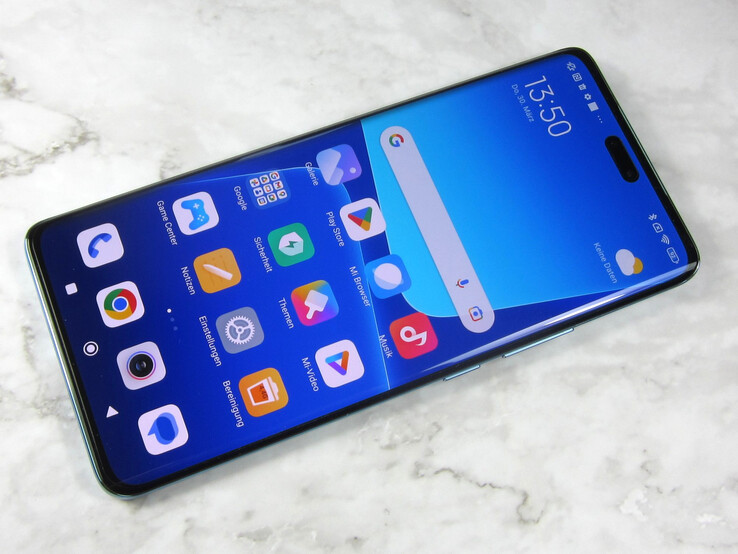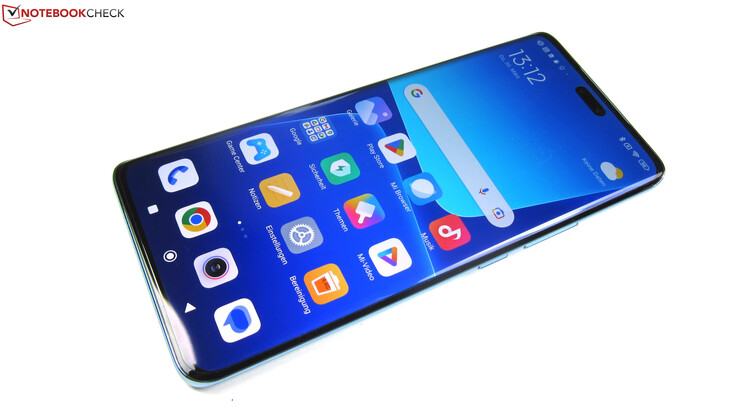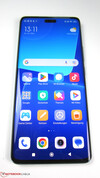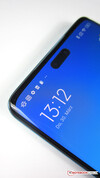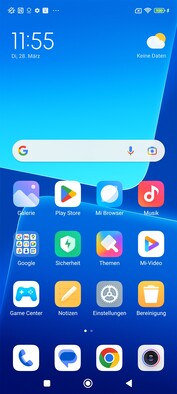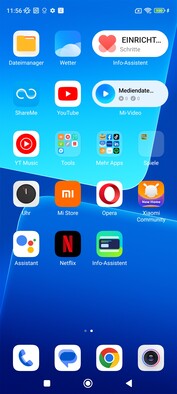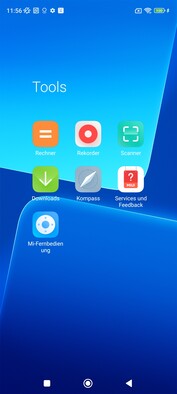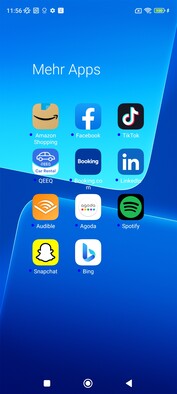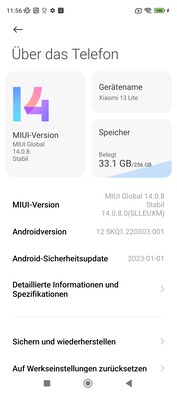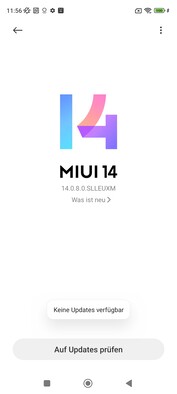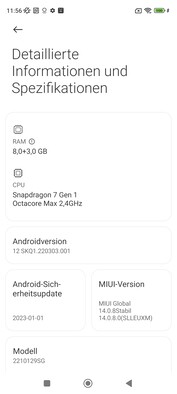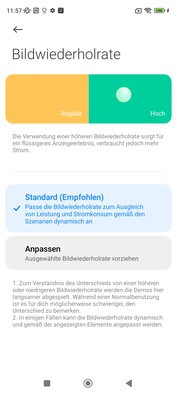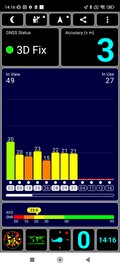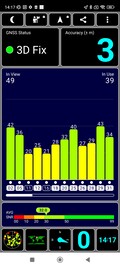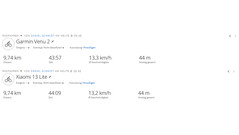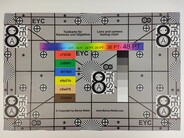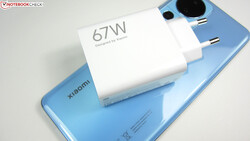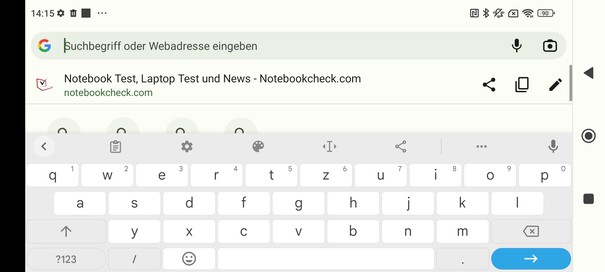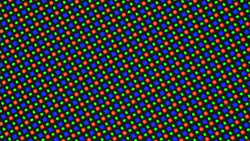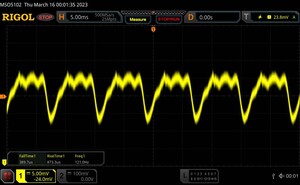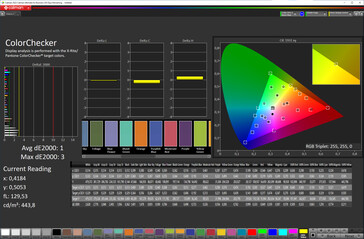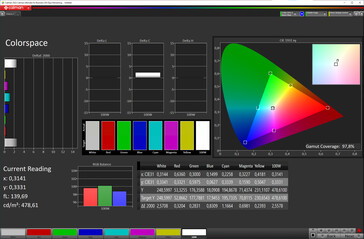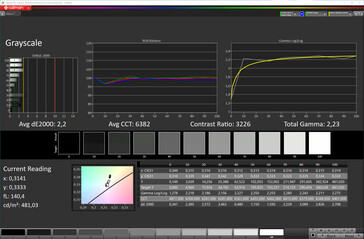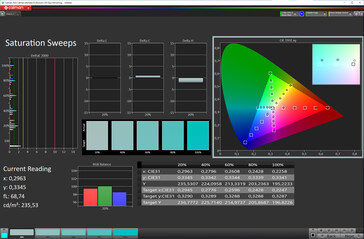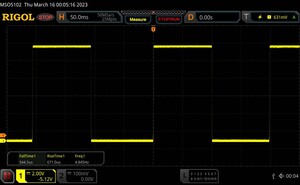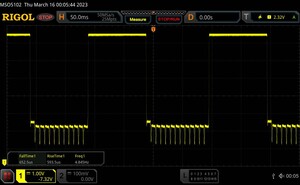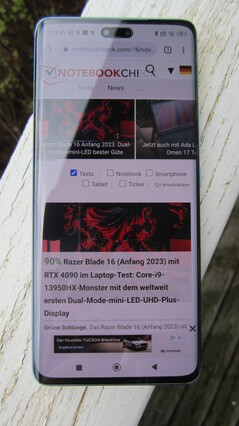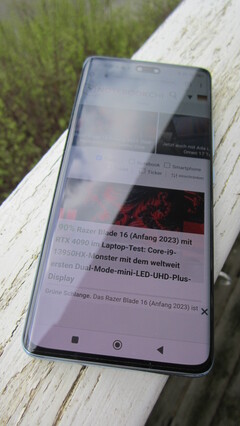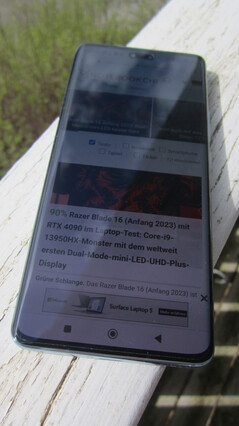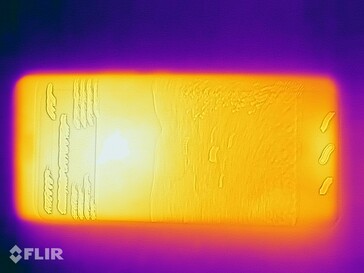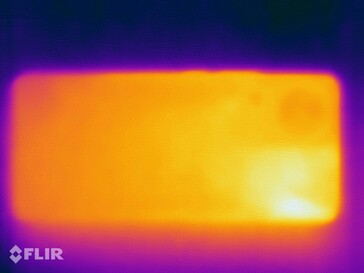Xiaomi 13 Lite review: Classy mid-range smartphone with an ambitious price tag
Xiaomi has presented its new generation of smartphones. The Xiaomi 13 series replaces the 12th series of last year and is currently available in three versions. In addition to the Xiaomi 13 and the Xiaomi 13 Pro, the manufacturer also offers a Lite version, the Xiaomi 13 Lite. Officially priced around US$450, it is the cheapest iteration of the series and thus differs significantly from the prices of its sister models, the Xiaomi 13 (~US$850) and Xiaomi 13 Pro (~US$1080).
The Xiaomi 13 Lite is technically similar to the Xiaomi 12 Lite in many respects and also falls in the middle class. Only a few major changes have been made, such as the camera setup, for the 108 MP main camera of the Xiaomi 12 Lite has been replaced by a 50 MP camera. In return, the front camera now sees double with its 32 MP main sensor now supported by an 8 MP depth sensor, which should ensure better bokeh effects. The battery capacity has also increased and is now 4500 mAh instead of the old 4300 mAh.
Possible competitors in comparison
Rating | Date | Model | Weight | Drive | Size | Resolution | Price |
|---|---|---|---|---|---|---|---|
| 86.4 % v7 (old) | 04 / 2023 | Xiaomi 13 Lite SD 7 Gen 1, Adreno 644 | 171 g | 256 GB UFS 2.2 Flash | 6.55" | 2400x1080 | |
| 85.8 % v7 (old) | 09 / 2022 | Google Pixel 6a Tensor, Mali-G78 MP20 | 178 g | 128 GB UFS 3.1 Flash | 6.10" | 2400x1080 | |
| 87.9 % v7 (old) | 03 / 2022 | Motorola Edge 30 Pro SD 8 Gen 1, Adreno 730 | 196 g | 256 GB UFS 3.1 Flash | 6.70" | 2400x1080 | |
| 85.6 % v7 (old) | 07 / 2022 | Nothing Phone (1) SD 778G+ 5G, Adreno 642L | 193.5 g | 256 GB UFS 3.1 Flash | 6.55" | 2400x1080 | |
| 83.4 % v7 (old) | 06 / 2022 | Samsung Galaxy A53 Exynos 1280, Mali-G68 MP4 | 189 g | 128 GB UFS 2.1 Flash | 6.50" | 2400x1080 | |
| 85.6 % v7 (old) | 09 / 2022 | Xiaomi 12 Lite SD 778G 5G, Adreno 642L | 173 g | 128 GB UFS 2.2 Flash | 6.55" | 2400x1080 |
Case - Curved display and glass back
Compared to the low-priced smartphones of the Redmi and Poco series, one immediately notices that the Xiaomi 13 Lite belongs to a higher quality series. At 171 grams, the Xiaomi 13 Lite is a tad lighter than its predecessor and also feels very good to hold due to its unchanged slim design.
Thanks to its glass back, the 7.3 millimeter flat smartphone feels pleasing in the hands and thus scores additional plus points compared to the Xiaomi 12 Lite, which had to make do with a plastic back cover. Since the glass back is very susceptible to fingerprints, we recommend using the smartphone in the supplied transparent protective case. This also prevents wobbling on flat surfaces, which is otherwise unavoidable due to the camera module protruding around 2.5 millimeters from the chassis.
In contrast to the Xiaomi 12 Lite, the Gorilla Glass 5 protected AMOLED display is rounded on the long sides, which is why the display-to-surface ratio is slightly better at 89 percent (Xiaomi 12 Lite: 88%). Because the front camera has two lenses, the camera notch has widened significantly and resembles the "Dynamic Island" of the iPhone 14 Pro models with its pill-shaped outline, which may not appeal to everyone. A protective film is applied to the curved display ex factory.
As with the Xiaomi 12 Lite, the frame of the Xiaomi 13 Lite is made of plastic and holds the front and back together sturdily. Creaking noises can be heard if the slim smartphone is twisted sideways with minimal effort. The display and back cover, on the other hand, prove to be very stable under pressure and can hardly be pressed in.
The Xiaomi 13 Lite is available in three color variants, namely "Lite blue" (like our test device), "Lite pink" and "Lite black".
Equipment - 8 GB RAM and up to 256 GB memory
Xiaomi officially offers the 13 Lite in the EU in only one storage variant: 8 GB of LPDDR4X RAM and 128 GB of UFS 2.2 storage for EUR 400-500, depending on location. Online, you can easily buy the second storage variant, which also offers 8 GB RAM and 256 GB storage space and is hardly more expensive. The smartphone does not have a microSD slot for memory expansion.
In addition to an infrared transmitter for devices such as cameras and home cinema devices, there is NFC, Bluetooth 5.2 and an OTG-capable USB-C port that works at USB 2.0 speed. However, the stereo speakers of the Xiaomi 12 Lite are no longer available on the successor. Instead, the Xiaomi 13 Lite has to make do with a single speaker located next to the USB-C port.
Software - Android 12 and MIUI 14
The Xiaomi 13 Lite runs Android 12 and version 14 of Xiaomi's in-house MIUI user interface. According to Xiaomi, the smartphone will receive three OS upgrades and four years worth of security updates. At the time of review (end of March), the Android security patch were from January 1, 2023 and therefore no longer particularly up to date.
In addition to the obligatory Google apps and some of the manufacturer's own tools such as File Manager, Mi Remote Control and Xiaomi Community, some third-party apps are also installed on the Xiaomi 13 Lite. But if you don't need Audible, Bing, Booking.com, Facebook, TikTok, Spotify and others, these can be simply uninstalled.
Communication and GNSS - Very fast WiFi 6E & precise GPS
The Xiaomi 13 Lite supports all current mobile phone standards, including 5G-Sub6. Owing to broad frequency coverage, which includes 13 5G and 21 4G bands, the smartphone should have little issue connecting to the mobile network at most locations.
Regarding WLAN, the Xiaomi 13 connects to WiFi networks via WiFi 6. Although it cannot communicate via the 6 GHz band, it is still very fast on account of the 160 MHz spectrum.
In tandem with our Asus ROG Rapture GT-AXE11000 reference router, the smartphone achieves stable and, above all, excellent transfer rates, which peak at 1757 MBit/s. In doing so, the Xiaomi 13 clearly surpasses its predecessor. Other mid-range competitors, such as the Google Pixel 6a and the Samsung Galaxy A53, cannot keep up with the Xiaomi 13 Lite in the Wi-Fi test.
| Networking | |
| iperf3 receive AXE11000 | |
| Xiaomi 13 Lite | |
| Motorola Edge 30 Pro | |
| Google Pixel 6a | |
| Average of class Smartphone (52 - 1857, n=182, last 2 years) | |
| Xiaomi 12 Lite | |
| Samsung Galaxy A53 | |
| iperf3 transmit AXE11000 | |
| Xiaomi 13 Lite | |
| Xiaomi 12 Lite | |
| Google Pixel 6a | |
| Motorola Edge 30 Pro | |
| Average of class Smartphone (49.8 - 1828, n=182, last 2 years) | |
| Samsung Galaxy A53 | |
| iperf3 transmit AXE11000 6GHz | |
| Average of class Smartphone (508 - 1945, n=91, last 2 years) | |
| Nothing Phone (1) | |
| iperf3 receive AXE11000 6GHz | |
| Average of class Smartphone (451 - 1870, n=91, last 2 years) | |
| Nothing Phone (1) | |
Localization of the Xiaomi 13 Lite takes place via GPS (L1), Glonass (L1), Galileo (E1) and Beidou (B1, B1C). This functions very swifly both indoors and outdoors at an accuracy of 3 meters.
We also tested the smartphone's real world tracking capabilities on a 10-kilometer bike ride, also taking the Garmin Venu2 fitness tracker along for direct comparison. The smartphone does its job very well, recording the route covered almost as precisely, aside from minimal outliers, and is thus ideally equipped for everyday navigation tasks à la Google Maps.
Telephony and Voice Quality
The Xiaomi 13 Lite supports VoLTE as well as Wi-Fi calls and can use two nano-SIM cards as well as one nano-SIM card together with an eSIM.
Under testing, the Xiaomi 13 Lite delivered good voice quality. The voices of the callers were reproduced clearly and naturally, and distracting background noise was suppressed quite reliably. In hands-free mode, a slight echo crept in from time to time, but the otherwise good intelligibility remained so.
Cameras - Dual selfie camera and Sony IMX766 with 50 MP
The Xiaomi 13 Lite uses a dual front camera consisting of a 32 MP selfie camera and an 8 MP depth sensor. This also explains the notch format, which is unusual by Android standards because it is pill-shaped, as it now houses two sensors instead of the usual one.
The selfies make appear decent in good lighting conditions and the 100° viewing angle means that several people can be included in the picture. The 8 MP sensor is responsible for depth information in portrait mode. Under testing, however, it does not really deliver any added value compared to standard selfie cameras.
On paper, the camera setup is a step backwards: Xiaomi omits the 108 MP main sensor of the Xiaomi 12 Lite (Samsung HM2) and installs the well-known Sony IMX766, which has a resolution of 50 MP and shoots 12 MP photos via 4-in-1 pixels. If you want full resolution, you can switch to the 50 MP picture mode.
Megapixel specs say little about the image quality, which is also evident in our tests. The main camera of the Xiaomi 13 Lite has to make do with less than half the MP number of the Xiaomi 12 Lite, but takes better pictures both in daylight and in poor light conditions and is thus far ahead in the mid-range range.
The Sony IMX766 captures contrasts and colors well. The colors fade somewhat in low residual light, but the level of detail is still above average, which is particularly noticeable in direct comparison with the Xiaomi 12 Lite. On the other hand, the main camera delivers only average quality in zoom shots, since photos no longer look very crisp at more than 2x magnification. The maximum zoom level is 10x.
The 8 MP ultra wide-angle camera and the 2 MP macro camera fall behind the 50 MP main sensor in terms of quality. The former does its job quite well, but struggles with blurring towards the edges. The macro camera hardly has any added value owing to its low resolution.
Videos are recorded in a maximum of 4K at 30 frames per second, while up to 60 FPS is possible with Full HD. The recordings are impressive and are reliably stable.
Image comparison
Choose a scene and navigate within the first image. One click changes the position on touchscreens. One click on the zoomed-in image opens the original in a new window. The first image shows the scaled photograph of the test device.
Daylight photo 1Daylight photo 2Ultra wide angle5x zoomLow lightUnder controlled lighting conditions, the Sony IMX766 of the Xiaomi 13 Lite reproduces colors reasonably realistically. However, the sensor struggles to accurately capture the cyan, darker brown and green tones. The main camera reproduces the test chart in detail, but still shows blurring towards the edges of the image. On the other hand, the test chart is still fully visible even at 1 lux of residual light.
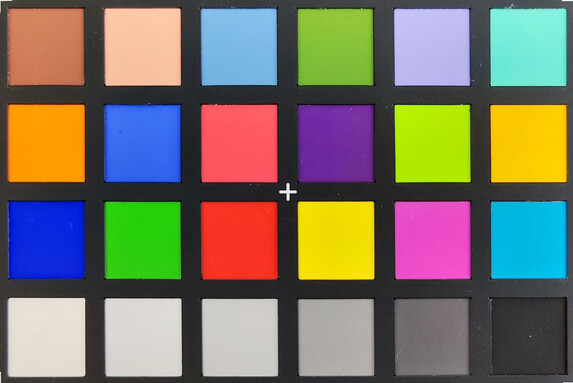
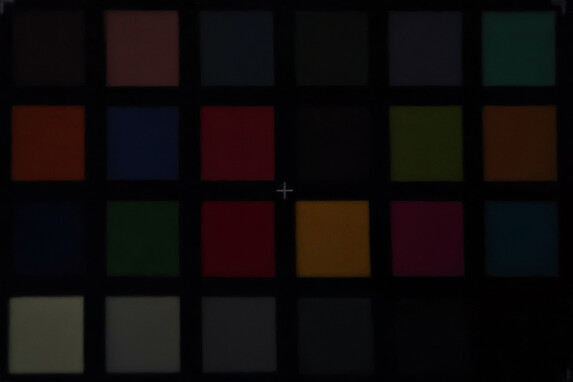
Accessories and Warranty - 67 watt power supply unit included in the scope of delivery
The scope of delivery of the Xiaomi 13 Pro includes a 67-watt power supply, a transparent protective cover, a USB cable (type A to C), a SIM tool, a quick start guide and another leaflet with safety instructions.
Xiaomi provides a 12-month warranty on its smartphone in the EU. This may differ in non-EU countries, so be sure to check with your vendor before purchasing.
Input Devices & Operation - Fingerprint sensor with heart rate monitor
The capacitive touchscreen of the Xiaomi 13 Lite works at a touch sampling rate of 240 Hz, reacts quickly to inputs and also implements them precisely. Together with a refresh rate of up to 120 Hz, this makes for nice and smooth operation.
The optical fingerprint sensor located under the display unlocks the Xiaomi 13 Lite quickly and reliably. Alternatively, biometric authentication is possible via the less secure 2D facial recognition method. Another plus point is the Always-on display, which can be switched on at any time and can permanently display elements such as the time, date and battery level.
A one-handed mode can also be activated under Additional settings. There is also the option of measuring the heart rate via a fingerprint sensor. A measurement takes 15 seconds.
Display - AMOLED panel with 1000 nits
The 6.55-inch AMOLED display of the Xiaomi 13 Lite has a resolution of 2400 x 1080 pixels, which ostensibly makes it no different from the Xiaomi 12 Lite. The refresh rate, which is up to 120 Hz depending on the content displayed, and support for all common HDR standards (Dolby Vision HDR10, HDR10+ and HLG) have also remained the same.
Compared to its predecessor, however, the AMOLED display has increased in terms of brightness. It averages 903.6 cd/m², which is even higher than the Xiaomi 12 Lite, where we measured an average of 772.9 cd/m².
With evenly distributed bright and dark image areas (APL18 measurement), the Xiaomi 13 Lite increases to a maximum of 1036 cd/m². A maximum of 516 cd/m² is possible when the brightness sensor is switched off. At the lowest brightness level, the luminance is 1.89 cd/m².
As in most smartphones with OLED panels, the display of the Xiaomi 13 Pro also flickers. Then again, because Xiaomi uses an eye-friendly DC dimming method at 1920 Hz, users who otherwise react sensitively to pulse width modulation should not be bothered by this.
Xiaomi's special DC dimming process, at a constant 120 Hz, is noticeable across the entire brightness spectrum on our oscilloscope. Small outliers can be seen in the 71-421 Hz frequency range.
| |||||||||||||||||||||||||
Brightness Distribution: 99 %
Center on Battery: 905 cd/m²
Contrast: ∞:1 (Black: 0 cd/m²)
ΔE ColorChecker Calman: 1 | ∀{0.5-29.43 Ø4.79}
ΔE Greyscale Calman: 2.2 | ∀{0.09-98 Ø5}
97.8% sRGB (Calman 2D)
Gamma: 2.23
CCT: 6382 K
| Xiaomi 13 Lite AMOLED, 2400x1080, 6.6" | Google Pixel 6a AMOLED, 2400x1080, 6.1" | Motorola Edge 30 Pro AMOLED, 2400x1080, 6.7" | Nothing Phone (1) OLED, 2400x1080, 6.6" | Samsung Galaxy A53 AMOLED, 2400x1080, 6.5" | Xiaomi 12 Lite AMOLED, 2400x1080, 6.6" | |
|---|---|---|---|---|---|---|
| Screen | 3% | -2% | -7% | -23% | -15% | |
| Brightness middle (cd/m²) | 905 | 758 -16% | 649 -28% | 620 -31% | 718 -21% | 757 -16% |
| Brightness (cd/m²) | 904 | 767 -15% | 649 -28% | 625 -31% | 730 -19% | 773 -14% |
| Brightness Distribution (%) | 99 | 93 -6% | 98 -1% | 98 -1% | 92 -7% | 97 -2% |
| Black Level * (cd/m²) | ||||||
| Colorchecker dE 2000 * | 1 | 0.9 10% | 1.18 -18% | 1.24 -24% | 1.62 -62% | 1.3 -30% |
| Colorchecker dE 2000 max. * | 3 | 2.5 17% | 2.07 31% | 2.31 23% | 4.21 -40% | 3.4 -13% |
| Greyscale dE 2000 * | 2.2 | 1.6 27% | 1.5 32% | 1.7 23% | 2 9% | 2.5 -14% |
| Gamma | 2.23 99% | 2.2 100% | 2.236 98% | 2.318 95% | 2.156 102% | 2.22 99% |
| CCT | 6382 102% | 6599 98% | 2538 256% | 6325 103% | 6545 99% | 6403 102% |
* ... smaller is better
Screen Flickering / PWM (Pulse-Width Modulation)
| Screen flickering / PWM detected | 120 Hz | ||
The display backlight flickers at 120 Hz (worst case, e.g., utilizing PWM) . The frequency of 120 Hz is very low, so the flickering may cause eyestrain and headaches after extended use. In comparison: 53 % of all tested devices do not use PWM to dim the display. If PWM was detected, an average of 8156 (minimum: 5 - maximum: 343500) Hz was measured. | |||
Series of measurements at a fixed zoom level and different brightness settings
The AMOLED display of the Xiaomi 13 Lite delivers very precise color representation. This can be brought about by switching from the standard color scheme, Vivid, to Original Color. The panel then delivers exemplary color reproduction with DeltaE values of well under 3, although it only uses the sRGB color space. In the standard Vivid setting, on the other hand, the much larger DCI-P3 color space is used.
Display Response Times
| ↔ Response Time Black to White | ||
|---|---|---|
| 1.22 ms ... rise ↗ and fall ↘ combined | ↗ 0.671 ms rise | |
| ↘ 0.5445 ms fall | ||
| The screen shows very fast response rates in our tests and should be very well suited for fast-paced gaming. In comparison, all tested devices range from 0.1 (minimum) to 240 (maximum) ms. » 5 % of all devices are better. This means that the measured response time is better than the average of all tested devices (20.3 ms). | ||
| ↔ Response Time 50% Grey to 80% Grey | ||
| 1.25 ms ... rise ↗ and fall ↘ combined | ↗ 0.5935 ms rise | |
| ↘ 0.6525 ms fall | ||
| The screen shows very fast response rates in our tests and should be very well suited for fast-paced gaming. In comparison, all tested devices range from 0.165 (minimum) to 636 (maximum) ms. » 5 % of all devices are better. This means that the measured response time is better than the average of all tested devices (31.7 ms). | ||
The Xiaomi 13 Lite performs very well outdoors thanks to its viewing angle stable and bright AMOLED panel. Even on sunny days, it still has enough brightness reserves to ensure good readability. Optionally, you can deactivate the auto-brightness in the display settings and switch on a sunlight mode instead to squeeze out the maximum brightness from the panel.
Performance - Premiere for the Snapdragon 7 Gen 1
The Xiaomi 13 Lite is the first smartphone in Germany to be equipped with the Snapdragon 7 Gen 1. The mid-range SoC uses four ARM Cortex-A710 performance cores with clock frequencies of up to 2.4 GHz and an efficiency cluster consisting of four Cortex-A510 cores with a clock frequency of 1.8 GHz. According to ARM, the performance cores are 10 percent faster and 35 percent more efficient than the Cortex-A78 cores. The efficiency cores are said to be 35 percent more powerful and 20 percent more efficient than the old Cortex-A55 cores.
The Snapdragon 7 Gen 1 delivers good mid-range performance in our tests. In the synthetic benchmarks, however, the performance advantage over the Snapdragon 778G 5G of the Xiaomi 12 Lite is quite small. The Google Tensor in the Google Pixel 6a and the Snapdragon 8 Gen 1 in the Motorola Edge 30 Pro are in a higher league, as expected.
| Geekbench 6.0 | |
| Single-Core | |
| Average of class Smartphone (n=1last 2 years) | |
| Xiaomi 13 Lite | |
| Average Qualcomm Snapdragon 7 Gen 1 (n=1) | |
| Multi-Core | |
| Xiaomi 13 Lite | |
| Average Qualcomm Snapdragon 7 Gen 1 (n=1) | |
| Average of class Smartphone (n=1last 2 years) | |
| UL Procyon AI Inference for Android - Overall Score NNAPI | |
| Xiaomi 13 Lite | |
| Google Pixel 6a | |
| Nothing Phone (1) | |
| Average of class Smartphone (3769 - 81594, n=138, last 2 years) | |
| Xiaomi 12 Lite | |
| Average Qualcomm Snapdragon 7 Gen 1 (7374 - 29413, n=5) | |
| Samsung Galaxy A53 | |
| AImark - Score v3.x | |
| Xiaomi 13 Lite | |
| Average Qualcomm Snapdragon 7 Gen 1 (668 - 47384, n=4) | |
| Average of class Smartphone (82 - 307528, n=127, last 2 years) | |
For graphics acceleration, the SoC uses the Adreno 644 GPU, which is said to be around 20 percent faster than the pixel accelerator integrated in the Snapdragon 778G 5G. In the synthetic benchmarks, the Xiaomi 13 Lite performs better than the Xiaomi 12 Lite, but the performance advantage is not significant, like in the synthetic benchmarks.
GFXBench (DX / GLBenchmark) 2.7: T-Rex Onscreen | 1920x1080 T-Rex Offscreen
GFXBench 3.0: on screen Manhattan Onscreen OGL | 1920x1080 1080p Manhattan Offscreen
GFXBench 3.1: on screen Manhattan ES 3.1 Onscreen | 1920x1080 Manhattan ES 3.1 Offscreen
GFXBench: on screen Car Chase Onscreen | 1920x1080 Car Chase Offscreen | on screen Aztec Ruins High Tier Onscreen | 2560x1440 Aztec Ruins High Tier Offscreen | on screen Aztec Ruins Normal Tier Onscreen | 1920x1080 Aztec Ruins Normal Tier Offscreen | 3840x2160 4K Aztec Ruins High Tier Offscreen
| 3DMark / Wild Life Extreme Unlimited | |
| Google Pixel 6a | |
| Motorola Edge 30 Pro | |
| Xiaomi 13 Lite | |
| Nothing Phone (1) | |
| Xiaomi 12 Lite | |
| Samsung Galaxy A53 | |
| 3DMark / Wild Life Extreme | |
| Google Pixel 6a | |
| Motorola Edge 30 Pro | |
| Xiaomi 13 Lite | |
| Nothing Phone (1) | |
| Xiaomi 12 Lite | |
| Samsung Galaxy A53 | |
| 3DMark / Wild Life Unlimited Score | |
| Google Pixel 6a | |
| Motorola Edge 30 Pro | |
| Xiaomi 13 Lite | |
| Nothing Phone (1) | |
| Xiaomi 12 Lite | |
| Samsung Galaxy A53 | |
| 3DMark / Wild Life Score | |
| Google Pixel 6a | |
| Motorola Edge 30 Pro | |
| Xiaomi 13 Lite | |
| Nothing Phone (1) | |
| Xiaomi 12 Lite | |
| Samsung Galaxy A53 | |
| 3DMark / Sling Shot Extreme (Vulkan) Unlimited Physics | |
| Xiaomi 13 Lite | |
| Nothing Phone (1) | |
| Samsung Galaxy A53 | |
| Xiaomi 12 Lite | |
| Google Pixel 6a | |
| 3DMark / Sling Shot Extreme (Vulkan) Unlimited Graphics | |
| Xiaomi 13 Lite | |
| Nothing Phone (1) | |
| Xiaomi 12 Lite | |
| Samsung Galaxy A53 | |
| Google Pixel 6a | |
| 3DMark / Sling Shot Extreme (Vulkan) Unlimited | |
| Xiaomi 13 Lite | |
| Nothing Phone (1) | |
| Xiaomi 12 Lite | |
| Samsung Galaxy A53 | |
| Google Pixel 6a | |
| 3DMark / Sling Shot Extreme (ES 3.1) Unlimited Physics | |
| Xiaomi 12 Lite | |
| Nothing Phone (1) | |
| Google Pixel 6a | |
| Xiaomi 13 Lite | |
| Samsung Galaxy A53 | |
| 3DMark / Sling Shot Extreme (ES 3.1) Unlimited Graphics | |
| Google Pixel 6a | |
| Xiaomi 13 Lite | |
| Nothing Phone (1) | |
| Xiaomi 12 Lite | |
| Samsung Galaxy A53 | |
| 3DMark / Sling Shot Extreme (ES 3.1) Unlimited | |
| Google Pixel 6a | |
| Xiaomi 13 Lite | |
| Nothing Phone (1) | |
| Xiaomi 12 Lite | |
| Samsung Galaxy A53 | |
| GFXBench (DX / GLBenchmark) 2.7 / T-Rex Onscreen | |
| Motorola Edge 30 Pro | |
| Nothing Phone (1) | |
| Xiaomi 13 Lite | |
| Xiaomi 12 Lite | |
| Samsung Galaxy A53 | |
| Google Pixel 6a | |
| GFXBench (DX / GLBenchmark) 2.7 / T-Rex Offscreen | |
| Motorola Edge 30 Pro | |
| Google Pixel 6a | |
| Xiaomi 13 Lite | |
| Nothing Phone (1) | |
| Xiaomi 12 Lite | |
| Samsung Galaxy A53 | |
| GFXBench 3.0 / Manhattan Onscreen OGL | |
| Motorola Edge 30 Pro | |
| Xiaomi 13 Lite | |
| Nothing Phone (1) | |
| Xiaomi 12 Lite | |
| Google Pixel 6a | |
| Samsung Galaxy A53 | |
| GFXBench 3.0 / 1080p Manhattan Offscreen | |
| Motorola Edge 30 Pro | |
| Google Pixel 6a | |
| Xiaomi 13 Lite | |
| Nothing Phone (1) | |
| Xiaomi 12 Lite | |
| Samsung Galaxy A53 | |
| GFXBench 3.1 / Manhattan ES 3.1 Onscreen | |
| Motorola Edge 30 Pro | |
| Google Pixel 6a | |
| Xiaomi 13 Lite | |
| Nothing Phone (1) | |
| Xiaomi 12 Lite | |
| Samsung Galaxy A53 | |
| GFXBench 3.1 / Manhattan ES 3.1 Offscreen | |
| Motorola Edge 30 Pro | |
| Google Pixel 6a | |
| Nothing Phone (1) | |
| Xiaomi 13 Lite | |
| Xiaomi 12 Lite | |
| Samsung Galaxy A53 | |
| GFXBench / Car Chase Onscreen | |
| Motorola Edge 30 Pro | |
| Google Pixel 6a | |
| Xiaomi 13 Lite | |
| Nothing Phone (1) | |
| Xiaomi 12 Lite | |
| Samsung Galaxy A53 | |
| GFXBench / Car Chase Offscreen | |
| Motorola Edge 30 Pro | |
| Google Pixel 6a | |
| Nothing Phone (1) | |
| Xiaomi 13 Lite | |
| Xiaomi 12 Lite | |
| Samsung Galaxy A53 | |
| GFXBench / Aztec Ruins High Tier Onscreen | |
| Motorola Edge 30 Pro | |
| Google Pixel 6a | |
| Xiaomi 13 Lite | |
| Nothing Phone (1) | |
| Xiaomi 12 Lite | |
| Samsung Galaxy A53 | |
| GFXBench / Aztec Ruins High Tier Offscreen | |
| Motorola Edge 30 Pro | |
| Google Pixel 6a | |
| Xiaomi 13 Lite | |
| Nothing Phone (1) | |
| Xiaomi 12 Lite | |
| Samsung Galaxy A53 | |
| GFXBench / Aztec Ruins Normal Tier Onscreen | |
| Motorola Edge 30 Pro | |
| Google Pixel 6a | |
| Xiaomi 13 Lite | |
| Nothing Phone (1) | |
| Xiaomi 12 Lite | |
| Samsung Galaxy A53 | |
| GFXBench / Aztec Ruins Normal Tier Offscreen | |
| Motorola Edge 30 Pro | |
| Google Pixel 6a | |
| Xiaomi 13 Lite | |
| Nothing Phone (1) | |
| Xiaomi 12 Lite | |
| Samsung Galaxy A53 | |
| GFXBench / 4K Aztec Ruins High Tier Offscreen | |
| Google Pixel 6a | |
| Xiaomi 13 Lite | |
| Nothing Phone (1) | |
| Xiaomi 12 Lite | |
Basemark GPUScore
The Xiaomi 13 Lite is convincing in terms of browser performance, but not faster overall than the Xiaomi 12 Lite.
| Jetstream 2 - 2.0 Total Score | |
| Average of class Smartphone (23.8 - 387, n=155, last 2 years) | |
| Motorola Edge 30 Pro (Chrome 99) | |
| Average Qualcomm Snapdragon 7 Gen 1 (64.3 - 115.8, n=5) | |
| Xiaomi 12 Lite (Chrome 105) | |
| Google Pixel 6a (Firefox 1ß4-2-ß) | |
| Xiaomi 13 Lite (Chrome 111.0.5563.115) | |
| Nothing Phone (1) (Chrome 103) | |
| Samsung Galaxy A53 (Chrome 101) | |
| Speedometer 2.0 - Result 2.0 | |
| Average of class Smartphone (15.2 - 643, n=132, last 2 years) | |
| Motorola Edge 30 Pro (Chome 99) | |
| Google Pixel 6a (Chrome 105.0.5195.79) | |
| Average Qualcomm Snapdragon 7 Gen 1 (61.5 - 87.4, n=5) | |
| Xiaomi 13 Lite (Chrome 111.0.5563.115) | |
| Xiaomi 12 Lite (Chrome 105) | |
| Nothing Phone (1) (Chome 103) | |
| Samsung Galaxy A53 (Chome 101) | |
| WebXPRT 4 - Overall | |
| Average of class Smartphone (27 - 306, n=148, last 2 years) | |
| Xiaomi 13 Lite (Chrome 111.0.5563.115) | |
| Average Qualcomm Snapdragon 7 Gen 1 (58 - 92, n=5) | |
| Xiaomi 12 Lite (Chrome 105) | |
| Google Pixel 6a (Chrome 105.0.5195.79) | |
| Nothing Phone (1) (Chrome 103) | |
| WebXPRT 3 - Overall | |
| Average of class Smartphone (38 - 380, n=41, last 2 years) | |
| Motorola Edge 30 Pro (Chrome 99) | |
| Xiaomi 13 Lite (Chrome 111.0.5563.115) | |
| Xiaomi 12 Lite (Chrome 105) | |
| Average Qualcomm Snapdragon 7 Gen 1 (106 - 114, n=2) | |
| Nothing Phone (1) (Chrome 103) | |
| Google Pixel 6a (Chrome 105.0.5195.79) | |
| Samsung Galaxy A53 (Chrome 101) | |
| Octane V2 - Total Score | |
| Motorola Edge 30 Pro (Chrome 99) | |
| Average of class Smartphone (2228 - 121337, n=201, last 2 years) | |
| Google Pixel 6a (Chrome 105.0.5195.79) | |
| Average Qualcomm Snapdragon 7 Gen 1 (21143 - 34866, n=7) | |
| Xiaomi 13 Lite (Chrome 111.0.5563.115) | |
| Xiaomi 12 Lite (Chrome 105) | |
| Nothing Phone (1) (Chrome 103) | |
| Samsung Galaxy A53 (Chrome 101) | |
| Mozilla Kraken 1.1 - Total | |
| Samsung Galaxy A53 (Chrome 101) | |
| Nothing Phone (1) (Chrome 103) | |
| Xiaomi 12 Lite (Chrome 105) | |
| Average Qualcomm Snapdragon 7 Gen 1 (1208 - 2686, n=5) | |
| Google Pixel 6a (Chrome 105.0.5195.79) | |
| Xiaomi 13 Lite (Chrome 111.0.5563.115) | |
| Average of class Smartphone (257 - 28190, n=156, last 2 years) | |
| Motorola Edge 30 Pro (Chrome 99) | |
* ... smaller is better
The UFS 2.2 storage delivers high transfer rates and is clearly superior to that of the Xiaomi 12 Lite, especially in sequential writing. The Xiaomi 13 Lite also performs much better in the 4 KB random reads and writes.
| Xiaomi 13 Lite | Google Pixel 6a | Motorola Edge 30 Pro | Nothing Phone (1) | Samsung Galaxy A53 | Xiaomi 12 Lite | Average 256 GB UFS 2.2 Flash | Average of class Smartphone | |
|---|---|---|---|---|---|---|---|---|
| AndroBench 3-5 | -8% | 29% | 21% | -35% | -28% | -15% | 62% | |
| Sequential Read 256KB (MB/s) | 1001.82 | 1312.64 31% | 1832 83% | 1638 64% | 510.1 -49% | 943.11 -6% | 908 ? -9% | 2212 ? 121% |
| Sequential Write 256KB (MB/s) | 871.96 | 712.94 -18% | 1028 18% | 1351.9 55% | 486.7 -44% | 486.78 -44% | 728 ? -17% | 1835 ? 110% |
| Random Read 4KB (MB/s) | 277.33 | 219.53 -21% | 277.7 0% | 240.6 -13% | 229.9 -17% | 196.37 -29% | 229 ? -17% | 293 ? 6% |
| Random Write 4KB (MB/s) | 301.41 | 225.61 -25% | 339.5 13% | 228.2 -24% | 210.8 -30% | 199.91 -34% | 249 ? -17% | 338 ? 12% |
Gaming - Touch sampling rate of 240 Hz
The Adreno 644 GPU of the Snapdragon 7 Gen 1, in conjunction with a touch sampling rate of 240 Hz, ensures good gaming performance on the Xiaomi 13 Lite. However, it is unable to fully utilize its 120 Hz screen in our three test games PUBG Mobile, Subway Surfers and Armajet.
Using our Gamebench test tool, the Xiaomi runs PUBG Mobile at HD/Ultra and at HDR/Ultra at a largely stable 40 fps (the Ultra HD and UHD settings are currently not supported). In the graphically undemanding Subway Surfers, the smartphone is limited to 60 fps, although it could deliver significantly more here. Armajet, which sets a frame rate limit of 90 Hz, is also throttled.
Emissions - Single speaker with Dolby Atmos
Temperature
In operation, Xiaomi's mid-range phone always stays cool and only heats up to a maximum surface temperature of 34.1 °C, even under full load. The energy-efficient Snapdragon 7 Gen 1 ensures that temperatures always remain moderate under the hood. 3DMark's Wild Life stress test provides proof of this.
The Xiaomi 13 Lite achieves stability of over 99 percent both in the moderate 3DMark Wild Life scenario and in the more demanding Wild Life Extreme scenario. This test scenario is consistently upheld at the same speed over the entire series of measurements without any significant performance losses.
(+) The maximum temperature on the upper side is 34.1 °C / 93 F, compared to the average of 35.2 °C / 95 F, ranging from 21.9 to 247 °C for the class Smartphone.
(+) The bottom heats up to a maximum of 32.6 °C / 91 F, compared to the average of 34 °C / 93 F
(+) In idle usage, the average temperature for the upper side is 28.4 °C / 83 F, compared to the device average of 32.9 °C / 91 F.
3DMark Wild Life Stress Test
| 3DMark | |
| Wild Life Stress Test Stability | |
| Samsung Galaxy A53 | |
| Xiaomi 13 Lite | |
| Nothing Phone (1) | |
| Xiaomi 12 Lite | |
| Motorola Edge 30 Pro | |
| Google Pixel 6a | |
| Wild Life Extreme Stress Test | |
| Xiaomi 12 Lite | |
| Xiaomi 13 Lite | |
| Nothing Phone (1) | |
| Samsung Galaxy A53 | |
| Motorola Edge 30 Pro | |
| Google Pixel 6a | |
Speakers
Two become one: While the Xiaomi 12 Lite was still equipped with stereo speakers, the Xiaomi 13 Lite only has a single speaker, although it also supports Dolby Atmos. The sound image is nevertheless quite thin, with a strong emphasis on the trebles.
Wired audio devices can be connected via USB-C adapter. Bluetooth 5.2 and all common Bluetooth codecs are available wirelessly (SBC, AAC, aptX, aptX HD, aptX Adaptive, aptX TWS+, LDAC and LDAC V1-4).
Xiaomi 13 Lite audio analysis
(+) | speakers can play relatively loud (91.6 dB)
Bass 100 - 315 Hz
(-) | nearly no bass - on average 27.8% lower than median
(+) | bass is linear (5.1% delta to prev. frequency)
Mids 400 - 2000 Hz
(±) | reduced mids - on average 7% lower than median
(+) | mids are linear (4.9% delta to prev. frequency)
Highs 2 - 16 kHz
(+) | balanced highs - only 3.6% away from median
(+) | highs are linear (1.6% delta to prev. frequency)
Overall 100 - 16.000 Hz
(±) | linearity of overall sound is average (17.2% difference to median)
Compared to same class
» 10% of all tested devices in this class were better, 8% similar, 82% worse
» The best had a delta of 11%, average was 35%, worst was 134%
Compared to all devices tested
» 31% of all tested devices were better, 8% similar, 61% worse
» The best had a delta of 4%, average was 24%, worst was 134%
Samsung Galaxy A53 audio analysis
(+) | speakers can play relatively loud (86.1 dB)
Bass 100 - 315 Hz
(-) | nearly no bass - on average 25.7% lower than median
(±) | linearity of bass is average (11.2% delta to prev. frequency)
Mids 400 - 2000 Hz
(±) | higher mids - on average 8.4% higher than median
(±) | linearity of mids is average (7.1% delta to prev. frequency)
Highs 2 - 16 kHz
(±) | higher highs - on average 5.3% higher than median
(+) | highs are linear (6.7% delta to prev. frequency)
Overall 100 - 16.000 Hz
(±) | linearity of overall sound is average (24.1% difference to median)
Compared to same class
» 55% of all tested devices in this class were better, 8% similar, 37% worse
» The best had a delta of 11%, average was 35%, worst was 134%
Compared to all devices tested
» 72% of all tested devices were better, 6% similar, 22% worse
» The best had a delta of 4%, average was 24%, worst was 134%
Battery Life - 4500 mAh in the Xiaomi 13 Lite
Power Consumption
The power consumption of the Xiaomi 13 Lite is low in a class comparison. In all load scenarios, the smartphone gets by on little energy and is even able to undercut the economical Xiaomi 12 Lite.
The scope of delivery includes a 67-watt power adapter, with which the 4500 mAh battery can be quickly charged. In our test, it took 56 minutes to recharge the battery from 0 to 100 percent. 50 percent is achieved after 16 minutes.
| Off / Standby | |
| Idle | |
| Load |
|
Key:
min: | |
| Xiaomi 13 Lite 4500 mAh | Google Pixel 6a 4410 mAh | Motorola Edge 30 Pro 4800 mAh | Nothing Phone (1) 4500 mAh | Samsung Galaxy A53 5000 mAh | Xiaomi 12 Lite 4300 mAh | Average Qualcomm Snapdragon 7 Gen 1 | Average of class Smartphone | |
|---|---|---|---|---|---|---|---|---|
| Power Consumption | -13% | -43% | -6% | -15% | -8% | -44% | -34% | |
| Idle Minimum * (Watt) | 0.74 | 0.68 8% | 1.2 -62% | 1 -35% | 0.9 -22% | 0.83 -12% | 1.012 ? -37% | 0.853 ? -15% |
| Idle Average * (Watt) | 1.56 | 1.56 -0% | 1.6 -3% | 1.2 23% | 1.3 17% | 1.78 -14% | 2.19 ? -40% | 1.43 ? 8% |
| Idle Maximum * (Watt) | 1.59 | 1.58 1% | 2.5 -57% | 1.5 6% | 1.6 -1% | 1.81 -14% | 2.3 ? -45% | 1.609 ? -1% |
| Load Average * (Watt) | 3.33 | 5.37 -61% | 5.2 -56% | 4.2 -26% | 5.7 -71% | 3.83 -15% | 5.84 ? -75% | 7.09 ? -113% |
| Load Maximum * (Watt) | 7.59 | 8.74 -15% | 10.4 -37% | 7.4 3% | 7.3 4% | 6.6 13% | 9.26 ? -22% | 11.2 ? -48% |
* ... smaller is better
Power consumption: Geekbench (150 cd/m²)
Power consumption: GFXBench (150 cd/m²)
Battery Life
The Xiaomi 13 Lite has a solid battery life and is practically as enduring as its predecessor. Times of almost 14 hours in simulated web surfing and almost 20 hours in video playback are not runtime records, but will ensure that users can comfortably get through the day on one battery charge.
| Xiaomi 13 Lite 4500 mAh | Google Pixel 6a 4410 mAh | Motorola Edge 30 Pro 4800 mAh | Nothing Phone (1) 4500 mAh | Samsung Galaxy A53 5000 mAh | Xiaomi 12 Lite 4300 mAh | |
|---|---|---|---|---|---|---|
| Battery runtime | -0% | -8% | -10% | -3% | -21% | |
| Reader / Idle (h) | 37.3 | 31.3 -16% | 33.1 -11% | 30.2 -19% | 40.5 9% | 26.1 -30% |
| H.264 (h) | 19.8 | 22 11% | 16.8 -15% | 17.7 -11% | 19.1 -4% | 14.6 -26% |
| WiFi v1.3 (h) | 13.7 | 12.8 -7% | 13.6 -1% | 15.4 12% | 14.8 8% | 11.9 -13% |
| Load (h) | 5.4 | 6 11% | 5.1 -6% | 4.3 -20% | 4.1 -24% | 4.7 -13% |
Pros
Cons
Verdict on the Xiaomi 13 Lite
The Xiaomi 13 Lite is a good mid-range smartphone that is able to hold its own against many upper-range models in terms of looks and build. The stylish and slim design of the smartphone is not the only impressive aspect; its internal components are also praiseworthy.
Like the Xiaomi 12 Lite, the camera is one of the highlights, although the number of megapixels in the sensor has shrunk from 108 to 50 MP. Then again, the Sony IMX766 in the Xiaomi 13 Lite takes significantly better photos and is one of the best smartphone optics in the mid-range range.
The Xiaomi 13 Lite convinces as a good mid-range smartphone, but is still a little too expensive for the performance it offers.
The many advantages that distinguished the Xiaomi 12 Lite have remained: a slightly brighter AMOLED panel with 120 Hz and an Always-on function, fast charging at 67 watts and good battery life. The change from the Snapdragon 778 5G to the Snapdragon 7 Gen 1, on the other hand, is rather unspectacular as the overall performance has improved only marginally.
Points of criticism of the Xiaomi 13 Lite include the mono speaker, especially since stereo speakers are installed in the predecessor. The wide selfie camera notch is not bound to please everyone either, as will the fact that the smartphone only comes with Android 12.
Alternatives to the Xiaomi 13 Lite include the Samsung Galaxy A53 and the Google Pixel 6a.
Price and Availability
Interested buyers can check prices and shipping costs directly via Aliexpress, which offers a global version of the smartphone in a wide variety of currencies. For example:
- USA: $469.00
- UK: £388.38
- Netherlands: €450,97
- India: RS 39,833.34
- Brazil: R$ 2.464,55
- Singapore: SG$ 643.51
- Canada: CA $645.86
- Australia: AU $714.66
- South Africa: ZAR 8,623.88
This list is not exhaustive. Of course, the Xiaomi 13 Lite may already be available for purchase in your country from local resellers/distributors at cheaper prices. Either way, these examples can serve as comparison values.
Prices are as of 12.04.2023 and are subject to change.
Xiaomi 13 Lite
- 04/06/2023 v7 (old)
Manuel Masiero
Transparency
The selection of devices to be reviewed is made by our editorial team. The test sample was provided to the author as a loan by the manufacturer or retailer for the purpose of this review. The lender had no influence on this review, nor did the manufacturer receive a copy of this review before publication. There was no obligation to publish this review. As an independent media company, Notebookcheck is not subjected to the authority of manufacturers, retailers or publishers.
This is how Notebookcheck is testing
Every year, Notebookcheck independently reviews hundreds of laptops and smartphones using standardized procedures to ensure that all results are comparable. We have continuously developed our test methods for around 20 years and set industry standards in the process. In our test labs, high-quality measuring equipment is utilized by experienced technicians and editors. These tests involve a multi-stage validation process. Our complex rating system is based on hundreds of well-founded measurements and benchmarks, which maintains objectivity. Further information on our test methods can be found here.




